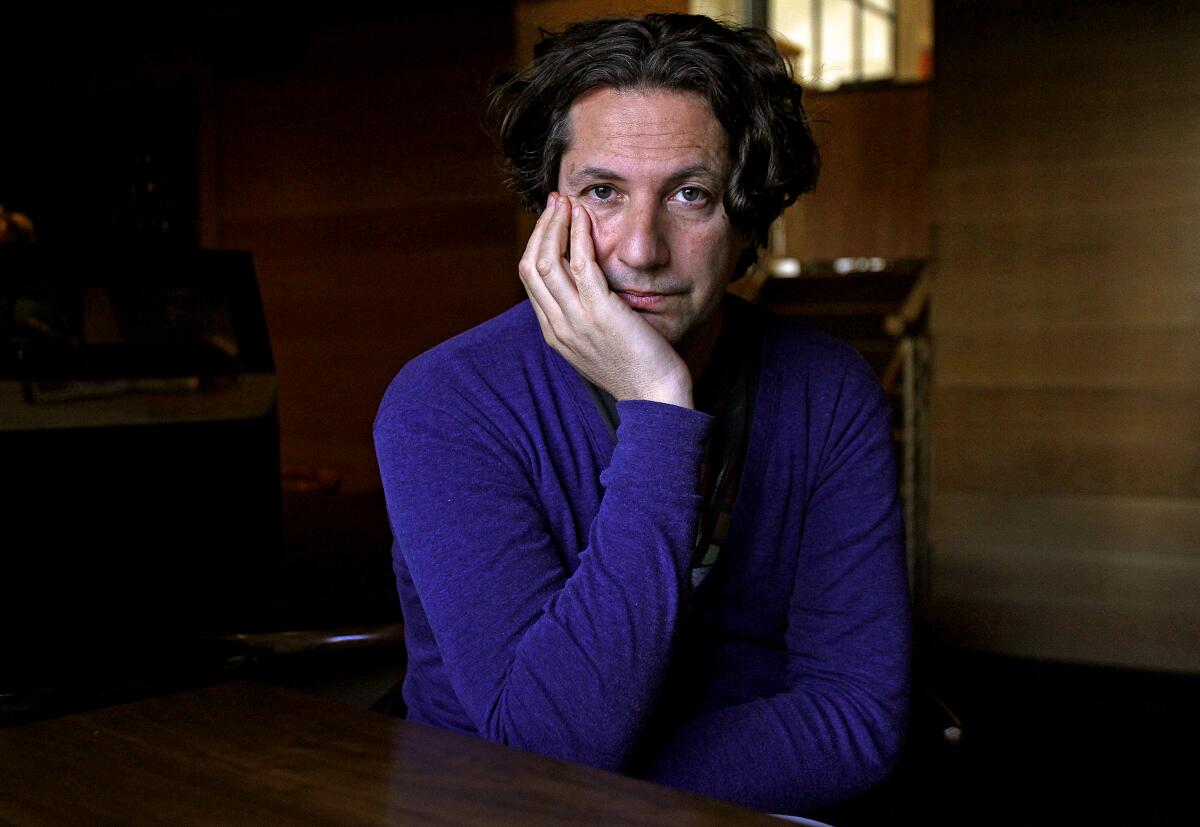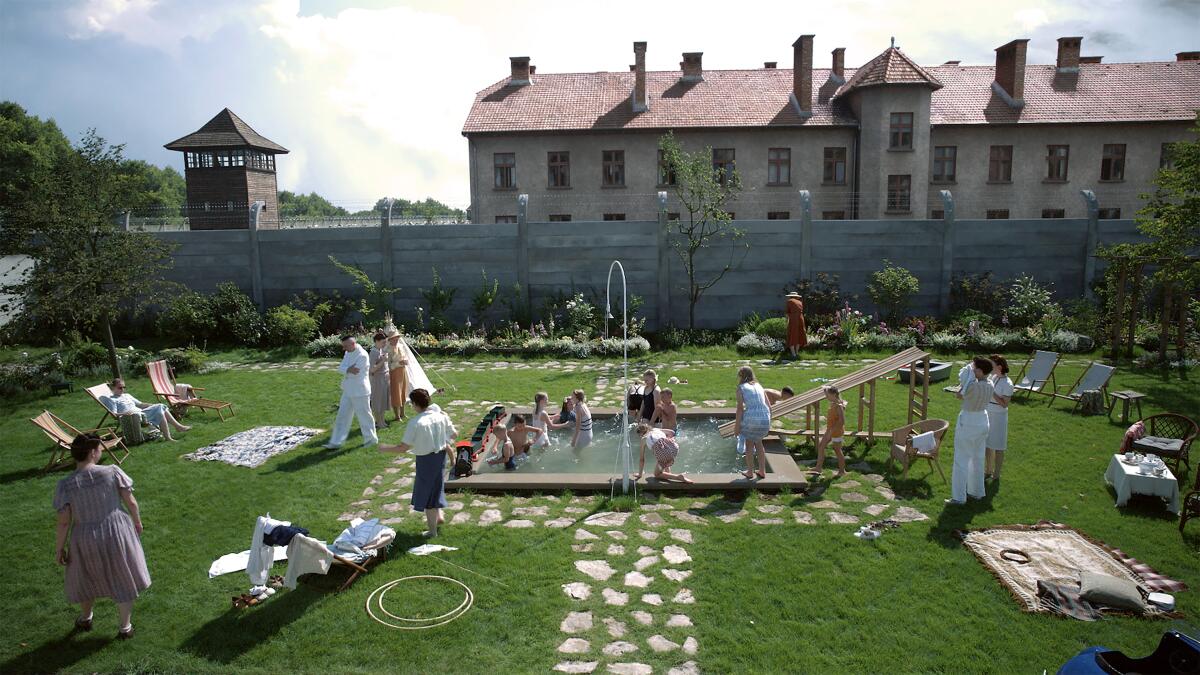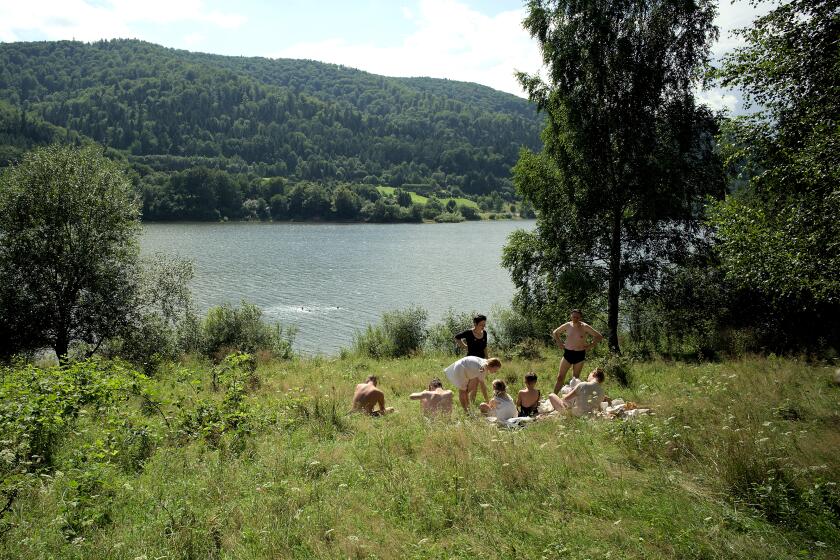Society’s shifting Holocaust views set Jonathan Glazer on a path to ‘Zone of Interest’

- Share via
Jonathan Glazer is admittedly not a prolific director. In the 23 years since his acclaimed feature film debut, “Sexy Beast,” he’s made just three other features. He’s never exactly sure why he tackles the films he makes, but this quartet, which includes 2004’s “Birth” and 2013’s “Under the Skin,” didn’t just land on his doorstep. He had to dig deep creatively to find them. That’s perhaps one reason it’s taken a decade for his latest celebrated effort, “The Zone of Interest,” to enter the cultural conversation.
Adapted from a Martin Amis novel and a rare British entry in the international film Oscar race, “Zone” depicts the seemingly everyday life of a German family during World War II. Except, this isn’t just any household, it’s the family of Rudolf Höss (Christian Friedel), his wife Hedwig (Sandra Hüller), and their five children. Höss was the real-life commandant of Auschwitz from 1940 to 1943, and his family lived in a beautifully decorated home right next to the Nazi death camp. They were so close that Glazer’s film hauntingly frames the juxtaposition of the Höss children playing in a vibrant garden with the sounds of screaming prisoners and the churn of the crematorium furnaces in the background. It is not just an artistic choice, but a historically accurate one.
As a Jewish man, Glazer remembers learning about the Holocaust when he was a child and thinking how unfathomable it all was. But as an adult, his motivations to tackle this subject were driven by a long list of considerations beginning with the opportunity to reach a new generation as well as his anger at the current political landscape. There was also his disgust at recent fictionalized accounts of these horrors that he feels are wrongheaded to the importance of the subject. And, lastly, the continuing proliferation of Holocaust deniers and revisionists.
“And then the ethics, should I do it? And if I’m going to do it, how should I do it and what must I avoid? So, all of that stuff is so interesting to me,” Glazer says. “It’s all so rich for me that I can spend a long time with it. And on the back of that investigation comes a film. There’s your 10 years right there.”
That investigation saw Glazer spend untold hours researching the Auschwitz Memorial archives. There he found numerous anecdotes from the prisoners in the camp and those who were forced to serve the Höss household that directly informed the project. He notes, “A lot of the things that are said in that film they said, I didn’t write. Hedwig sitting at that table telling the Polish girl in the house, ‘If I wanted, my husband would spread your ashes across the fields of Babice’? I didn’t write that. That’s her line, word for word that comes from the archives,” Glazer says of the sub-camp where prisoners were forced to farm. “[Hedwig’s] anger at the idea of having to leave that house? I didn’t write that. That’s what happened.”

But for Glazer, it was standing at that actual wall, seeing the proximity of those people, how they lived, and what they did abutting the death camps that stayed with him the most.
“I was imagining myself as a prisoner on the camp side of that wall, hearing those children splashing in that pool. And then being on that side of the wall where the kids are splashing in the pool and imagining the prisoners on the other side,” Grazer says. “What you see in the film is a simulation of what happened, how they lived and where they lived. It’s the distance in the house and the chimney you see in the film is exactly the same distance between the house and their chimney. There’s no fantasy staging here. This is as it was.”
One of the initial pieces of visual history Glazer found in the archives was a roll of film that Höss shot of his family. An album where his kids are playing in the garden and you can see the pool, the flowers, the garden pathways and the greenhouse. But something is intentionally missing from the photos, any hint of the prison wall.
The British-born filmmakers Jonathan Glazer (‘The Zone of Interest’) and Steve McQueen (‘Occupied City’) have made two of this year’s essential Cannes Film Festival titles.
“That tells you a lot about the psychology of the man in a sense,” Glazer says. “Imagine that after the war, he’s got this photo album of the four years he spent in that particular posting with his wife and his family. There isn’t a shot of a [camp] chimney, there isn’t a shot of the prison wall. Those views are not photographed. And so, in a way, our job was to take those pictures that he didn’t take.”
To draw the viewer’s attention, Glazer and his director of photography, Łukasz Żal, used 10 static cameras strategically placed in a recreation of the Höss homestead (a repurposed building found just 200 yards from the real location) to film a majority of the movie. The lack of dolly shots, soft focus, back light, etc., gives the proceedings an unexpected intimacy. It almost seems like it’s happening in contemporary times.
“The whole aim of the film was to make it as present tense [as possible]. I kept using the phrase ‘present tense’ as it has to be now,” Glazer says. “It has to have an urgency to it. It can’t be a story, an event that happened in history 80 years ago and therefore we are somehow safe from it. In other words, a museum piece. I had no interest in that.”
More to Read
From the Oscars to the Emmys.
Get the Envelope newsletter for exclusive awards season coverage, behind-the-scenes stories from the Envelope podcast and columnist Glenn Whipp’s must-read analysis.
You may occasionally receive promotional content from the Los Angeles Times.







